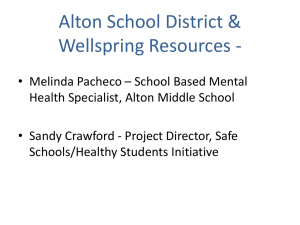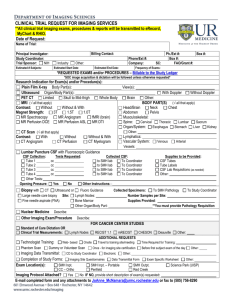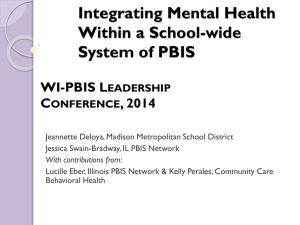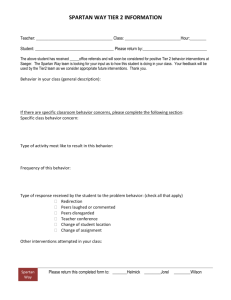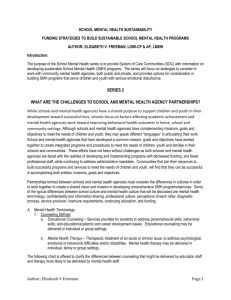school mental health sustainability
advertisement
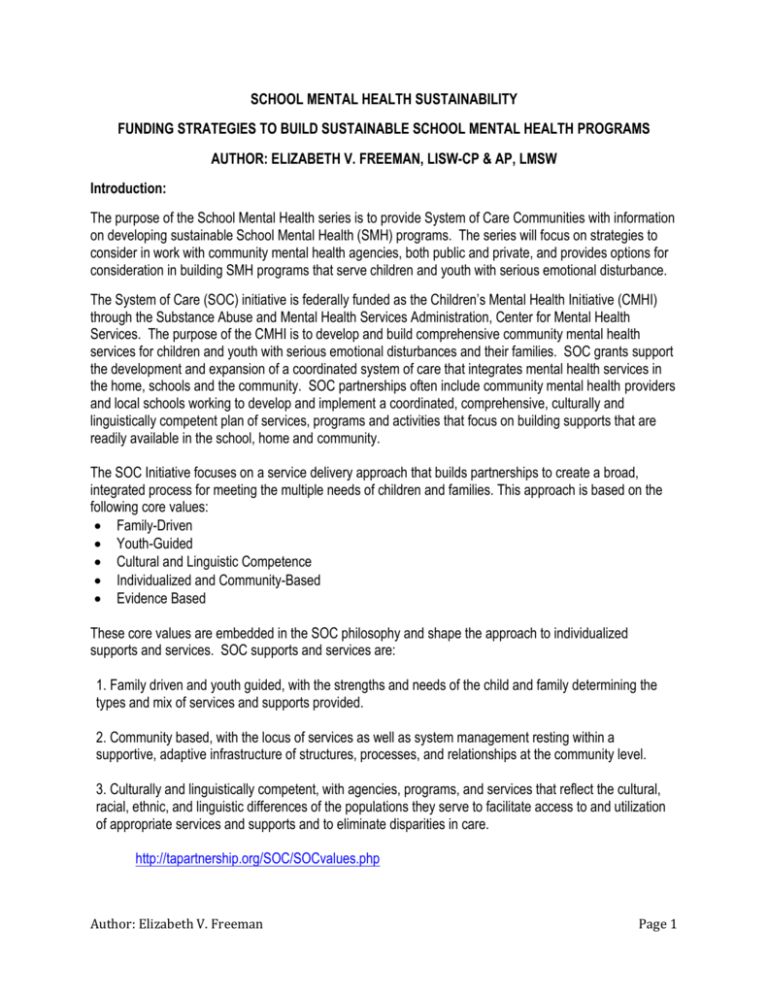
SCHOOL MENTAL HEALTH SUSTAINABILITY FUNDING STRATEGIES TO BUILD SUSTAINABLE SCHOOL MENTAL HEALTH PROGRAMS AUTHOR: ELIZABETH V. FREEMAN, LISW-CP & AP, LMSW Introduction: The purpose of the School Mental Health series is to provide System of Care Communities with information on developing sustainable School Mental Health (SMH) programs. The series will focus on strategies to consider in work with community mental health agencies, both public and private, and provides options for consideration in building SMH programs that serve children and youth with serious emotional disturbance. The System of Care (SOC) initiative is federally funded as the Children’s Mental Health Initiative (CMHI) through the Substance Abuse and Mental Health Services Administration, Center for Mental Health Services. The purpose of the CMHI is to develop and build comprehensive community mental health services for children and youth with serious emotional disturbances and their families. SOC grants support the development and expansion of a coordinated system of care that integrates mental health services in the home, schools and the community. SOC partnerships often include community mental health providers and local schools working to develop and implement a coordinated, comprehensive, culturally and linguistically competent plan of services, programs and activities that focus on building supports that are readily available in the school, home and community. The SOC Initiative focuses on a service delivery approach that builds partnerships to create a broad, integrated process for meeting the multiple needs of children and families. This approach is based on the following core values: Family-Driven Youth-Guided Cultural and Linguistic Competence Individualized and Community-Based Evidence Based These core values are embedded in the SOC philosophy and shape the approach to individualized supports and services. SOC supports and services are: 1. Family driven and youth guided, with the strengths and needs of the child and family determining the types and mix of services and supports provided. 2. Community based, with the locus of services as well as system management resting within a supportive, adaptive infrastructure of structures, processes, and relationships at the community level. 3. Culturally and linguistically competent, with agencies, programs, and services that reflect the cultural, racial, ethnic, and linguistic differences of the populations they serve to facilitate access to and utilization of appropriate services and supports and to eliminate disparities in care. http://tapartnership.org/SOC/SOCvalues.php Author: Elizabeth V. Freeman Page 1 A centralized focus of systems of care is building the infrastructure needed to result in positive outcomes for children, youth, and families. (http://www.childwelfare.gov/pubs/soc/ Partnerships with local schools can be a key feature of the SOC infrastructure and a means for developing convenient access to mental health services and supports. The purpose of building SMH programs is to develop a coordinated, comprehensive plan of evidence-based programs, activities, and services that address the various mental health needs of students, provide student/family supports and resources, and promote positive learning environments for all. The series will focus on some key questions to consider in building sustainable comprehensive SMH programs: 1. Why SMH? What is the connection to System of Care initiatives? 2. What are the challenges to school and mental health agency partnerships? 3. How do SOC Community leaders work with community agencies/organizations to overcome challenges to develop a sustainable SMH program? 4. What are some of the lessons learned from experienced communities on sustaining SMH programs? Author: Elizabeth V. Freeman Page 2 SERIES 1 WHY SCHOOL MENTAL HEALTH? WHAT IS THE CONNECTION TO SYSTEM OF CARE? SOC provides schools and communities the opportunity to develop comprehensive programming in schools to address the various mental health needs experienced by students. This is accomplished by offering student supports to ensure that they are ready to learn, both physically and emotionally. Resources are also provided to assist students and their families to cope with the stress of daily living, as well as learn new strategies to successfully address current problems. SOC initiatives are based on national research that incorporates proven approaches to treatment interventions for students with mental health disorders and/or substance abuse problems, and interventions to increase healthier functioning among students in schools and in the community through developing a comprehensive system of supports. Schools are a natural environment for young people and Systems of Care can develop SMH programs that can address the mental, emotional and behavioral disorders that occur among students. SMH programs provide access to screening and early assessment to identify mental health (MH) disorders, and develop intervention programs to address student/family needs. The SOC initiatives promote development of comprehensive SMH programs that address issues such as quick access to treatment providers and services, and prompt intervention and treatment for the difficulties a child/youth with mental health issues experiences at school. According to the National Research Council and Institute of Medicine at the National Academy of Sciences, there is much evidence to support the development of SMH prevention and intervention programs such as: Prevention/intervention programs often help children, families, and schools build strengths that support well-being, Reduction of mental health disorders in young people by teaching them coping skills, and Development of well-designed programs that are sustained over the long term. An argument for School Mental Health Promotion Over the past 20 years several national centers have done extensive research in school programs that promote development of a comprehensive whole school mental health program model that promotes development of SMH programs that address prevention, early intervention and treatment provision. The goal of promoting whole-school mental health programs is to develop community schools that are safe, healthy and provide a positive school climate to grow and learn. A mentally healthy student is a student who attends school ready to learn, is actively engaged in school activities, has positive/quality relationships, supportive and caring connections with adults and young people, uses appropriate problem solving skills, has non-aggressive behaviors, and adds to the positive school culture. The whole school mental health model addresses three tiers of prevention and intervention: Tier 1: Universal Supports and Interventions – broad whole school mental health promotion; Tier 2: Targeted/Group Support and Interventions – early intervention for students at risk of developing emotional difficulties; and Tier 3: Intensive Individualized Supports and Interventions. Tier 3 is the area of focus for the children/youth in SOC initiatives. Tier 3 offers school-based intervention to assist children/youth to learn Author: Elizabeth V. Freeman Page 3 coping skills to address their mental health difficulties, to increase school success and, for those students in more restrictive settings, to move into less restrictive classroom settings in the whole-school approach to mental health prevention and intervention in Tiers 1 and 2. Tier 1: Development of universal supports and interventions in SMH programs includes the concepts of MH promotion and prevention programs to address the multiple needs of all students and their families through a whole-school prevention program. SMH promotes healthy student emotions and behaviors through the use of whole-school, evidence-based programs such as Positive Behavior Interventions and Supports (PBIS). PBIS is an example of a universal program that promotes a positive school climate, positive teacher/school staff responses, and healthy student behaviors. (www.pbis.org) Tier 2: Development of targeted/group supports and interventions in SMH programming includes early intervention programs in schools to provide staff and students with training and skill development toward healthier behaviors and address social issues such as bullying, violence, safety, and substance abuse. Intervention programs target at-risk behaviors of students such as fighting, bullying, lack of social and problem solving skills. Often mental health providers assist school staff in training and development of early intervention strategies and programs. Tier 3: Development of Intensive/Individual Supports and Interventions include mental health treatment services to address indicated and more severe mental health diagnoses that may be needed to immediately address emotional and behavioral issues exhibited by students and provide individual and family interventions. SOC principles support the development of programs that engage students both socially and emotionally thus producing student outcomes of mentally healthy students. In developing partnerships with schools and community mental health providers, SOC initiatives are able to build comprehensive, culturally and linguistically competent programs through the creation of safe school environments and mental health activities to prevent, and provide early intervention for mental health problems. These programs support healthy student development, positive social and emotional skills that support learning, good problem solving skills, positive choices/behaviors and healthy relationships. SOC initiatives that partner with SMH programs that include culturally and linguistically competent activities and evidence-based programs will be able to address prevention, early intervention and treatment for students experiencing mental health difficulties/diagnoses. These activities and programs promote a positive school climate that enhances the development of students’ mental health, and positive social and emotional skills which will increase student positive behaviors and decrease high-risk behaviors. Examples of SOC initiatives that have partnered with community mental health providers and schools to develop various models of comprehensive SMH programs as follows: Author: Elizabeth V. Freeman Page 4 1. SMH Program – district led/employed a. Tier 1: Universal Interventions and Supports – school district provides evidence-based program through current or additional district employed staff (e.g. guidance counselors, social workers, psychologists, nurses, paraprofessional staff). Examples: Psychologists provide professional development to school administrative and professional staff on topics of MH. School teachers provide classroom presentations/lessons on evidence based programs school-wide. School nurses provide professional development on school health awareness and education for students. School guidance counselors and/or school social workers are trained as trainers in evidence based programs/programming and provide training (initial and booster) for teachers and other professional staff, and provide coaching on classroom presentations. b. Tier 2: Targeted Interventions and Supports – school district provides additional interventions for students and families at risk of problems in the social/emotional domain in order to deter and/or alleviate future problems and move students toward healthier functioning. District staff may include: guidance counselors, social workers, psychologists, nurses, and paraprofessional staff. Examples: District-employed staff provide early intervention programming during the school day or after-school hours (e.g. small groups in various topics are provided for students/parents such as anger management, skills for living, working with your ADHD child/youth, etc.). District-employed staff provide early intervention short-term individual counseling sessions for students/parents (3 to 5 sessions). School nurses provide health awareness and education for students with various health problems (e.g. asthma, diabetes, etc.). c. Tier 3: Intensive/Individualized Interventions and Supports – school district support staff provide additional interventions for students and families experiencing mental health difficulties in order to decrease current problems, increase social/emotional functioning, and/or alleviate future problems toward healthier functioning. District staff may include: guidance counselors, social workers, psychologists, and nurses practitioners. Examples: Licensed mental health counselors such as school psychologists, clinical psychologists and clinical social workers provide screening, assessment, individual and family counseling for students and their families, Master school social workers provide targeted interventions for students/families in order to learn specific coping skills to deal with MH diagnoses, e.g. coping with ADHD, depression, anxiety, post-traumatic stress disorder, conduct disorders, etc., and Nurse practitioners provide medication monitoring for students who are prescribed medication for various MH disorders, meet with parents/guardian to discuss student functioning related to medication, and provide progress reports to prescribing physician. 2. School/Community Partnerships – consist of collaborative agreements between the school district and community MH agency network to provide various levels of SMH services and programming. The school district and local MH agency enter into a contractual agreement specifying the type of services/resources to be provided by MH agency and school district. The MH agency supplies the Author: Elizabeth V. Freeman Page 5 typical services provided in a local MH clinic , as well as assists/joins the SMH team in the development of a comprehensive array of MH programming. a. Tier 1: Universal Interventions and Supports – SMH counselor is trained in evidence-based programs and is able to assist teachers/school staff in working with and providing interventions to students with targeted and intensive-level needs. b. Tier 2: Targeted Interventions and Supports – SMH counselor works with SMH intervention team to determine students in need of additional assistance through the use of small intervention groups such as social skill development for students with various MH diagnoses. These may include skillbuilding groups for a targeted group of students such as anger management, dealing with stress, positive peer relationships, or a strengthening families program to assist a targeted group of individual students and their families. c. Tier 3: Intensive/Individualized Interventions – SMH counselors work with school guidance and SMH intervention team to target students for more intensive therapeutic services. Family-driven, youth-guided wraparound planning can be facilitated by either district or MH center staff. Intensivelevel/Individualized programming may include more intensive therapeutic interventions for individual students and their family such as Brief Therapy or Cognitive Behavior Therapy. 3. School contract with public health agency (e.g. financial support through state and/or county funds, health dept, school based health centers, hospitals, etc.). a. School nurses work in school-based health clinics, wellness centers, and family resource centers to assist SMH intervention teams in the provision of health services, education and wellness programs, and counseling for students/parents around health issues. b. School-based health clinics have the ability to hire mental health professionals to provide various SMH treatment/services (e.g. M.D., physician’s assistant, psychiatric nurse, social workers, MH counselors, etc.). Partnerships between the school and community mental health agency ensure development of programs and services on site at school. The school-based programs are able to address the mental health challenges and issues for students and their families, and provide resources and skills to promote healthier functioning. MH agencies often provide staff to work alongside school personnel in developing and implementing programs around school climate, crisis management, violence prevention, drug/alcohol prevention, mental health/behavioral health consultation to teachers, administrators, nurses, and ancillary staff. In addition, these MH professionals assist with addressing students’ behavioral/social/emotional needs, and they work with early childhood school and community staff to provide prevention and early intervention programs, as well as therapeutic interventions for students and their families. SOC grantees collect data related to the individual student functioning to include mental health progress toward healthier functioning, substance use, family and living condition, employment status, social connectedness, access to treatment, retention in treatment, and criminal justice status. Additionally, collection of additional data related to program development and process provides information on evidencebased program outcomes and fidelity, capacity building activities that promote positive school climate, and sustainability of evidence-based programs. The collection of additional data will provide an argument to sustain successful programs. Data is an extremely important tool to obtain buy-in from school districts, community partner organizations, and state/local agencies to obtain future funding resources. Data is often the key to convincing policy makers, funders and communities to provide funding for a program and/or service that has proven effective. Author: Elizabeth V. Freeman Page 6 The SOC community that partners with schools to develop a full range of mental health programming will support children/youth and their families to have a successful school experience and move toward healthy functioning and successful integration into the community in which they live. RESOURCES A. Non-Profit Organizations (Websites that may be partners beneficial for SMH functions) 4H Clubs, http://4-h.org Boys/Girls Clubs of America, http://www.bgca.org Communities In Schools, http://communitiesinschools.org United Way, Back to School, Education, “assisting individuals/families achieve their human potential through education, income stability and healthy lives…” http://liveunited.org B. Advocacy Organizations (Websites that are good partners beneficial to advocate for SMH funding/sustainability) I. State/Community Mental Health America, find in your community, http://www.nmha.org National Alliance on Mental Illness, http://www.nami.org II. Nationall SAMHSA, http://www.samhsa.gov Technical Assistance Partnership for Child and Family Mental Health, http://www.tapartnership.org NASBHC, School MH resources, http://www.nasbhc.org/site/c.jsJPKWPFJrH/b.2642293/k.85AC/mental_health.htm NIMH, MH Topics, http://www.nimh.nih.gov/health/topics/index.shtml National Association of School Psychologists, information for educators, students, families http://www.nasponline.org C. SMH websites beneficial for information and program development American School Counselor Association (ASCA) http://www.schoolcounselor.org/ Center for Mental Health in Schools at UCLA http://smhp.psych.ucla.edu Center for School-Based Mental Health Programs (CSBMHP) – Miami University-Ohio http://www.units.muohio.edu/csbmhp/ Center for School Mental Health (CSMH) - University of Maryland, Baltimore http://csmh.umaryland.edu Missouri – Center for the Advancement of Mental Health Practices in Schools http://schoolmentalhealth.missouri.edu/about.htm National Association of School Psychologists (NASP) http://www.nasponline.org/index.aspx National Center for Mental Health Promotion and Youth Violence Prevention (Promote-prevent guides on SMH program development) http://www.promoteprevent.org/publications/pp-guides School Mental Health resources for clinicians, educators, families, students, foster care, training, conferences, newsletters, etc. http://www.schoolmentalhealth.org School Mental Health Project, training series funded by Duke Endowment http://eahec.ecu.edu/smhp.cfm School Social Work Association of America (SSWAA) http://www.sswaa.org/index.html Author: Elizabeth V. Freeman Page 7 SharedWork.org – The IDEA Partnership and the Center for School Mental Health (CSMH) has created a mechanism for the exchange of information and the ability to pursue a shared agenda. http://www.sharedwork.org REFERENCES Technical Assistance Partnership for Child and Family Mental Health, Core Values http://tapartnership.org/SOC/SOCvalues.php Center for Substance Abuse Treatment. Definitions and Terms Relating to Co-Occurring Disorders. COCE Overview Paper 1. DHHS Publication No. (SMA) 07-4163. Rockville, MD: Substance Abuse and Mental Health Services Administration, and Center for Mental Health Services, 2007. National Research Council and Institute of Medicine, National Academy of Sciences. Preventing Mental, Emotional, and Behavioral Disorders Among Young People: Progress and Possibilities. Washington, DC: National Academy of Sciences, 2009. NCMHPYVP, Education Development Center, Inc. Realizing the Promise of the Whole-School Approach to Children’s Mental Health: A Practical Guide for Schools. Newton, MA: EDC, Inc., 2009. Department of Health and Human Services, Substance Abuse and Mental Health Services Administration, Grants to Expand Substance Abuse Treatment Capacity in Targeted Areas of Need – Local Recovery Oriented Systems of Care (Short title: TCE - Local ROSC), Request for Applications (RFA) No. TI-10-007, 2010. Mental Health: A Report of the Surgeon General. Rockville, MD: Department of Health and Human Services, Substance Abuse and Mental Health Services Administration, Center for Mental Health Services, National Institutes of Health, National Institute of Mental Health, U.S. Department of Health and Human Services, 1999. http://www.surgeongeneral.gov/library/mentalhealth/home.html). Way to Go – School Success for Children with Mental Health Care Needs, Bazelon Center for Mental Health Law, March 2006. (http://systemsofcare.samhsa.gov/pdfs/SOC%20Work_Educators11_22_SF_GB.pdf) Author: Elizabeth V. Freeman Page 8
